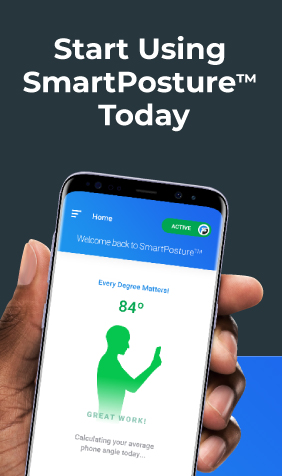How’s your posture right now? It’s amazing how just reading the word posture makes you straighten up. You become instantly aware of an unconscious slouch.
Before we talk about ways to improve, think about how you feel when you’re in poor posture. Is there tension in your neck or strain on your back? Are your shoulders rolled forward or shrugged to your ears? How much of your day are you spending this way? 1, 3, 8 hours?
Are you ready to make a change? Try out these easy ways to tune in to your posture and start developing healthier habits.
- Breathe deeply
Sounds simple, right? Well, it can be. Breathing and posture are closely connected. When you consciously take a breath, you become more aware of your body. It’s harder to breathe deeply when you’re hunched over, so you naturally straighten up.
Take a deep breath. Feel how your body shifts and your posture improves?
 Make a point of taking deep breaths throughout the day. If you have trouble remembering, create triggers to remind you. It could be taking a deep breath the moment before you hit send on an email, after you take a drink, or when you get on an elevator. The key is to begin to build this breathing practice into your daily routines. Do so, and you’ll start to feel the impact.
Make a point of taking deep breaths throughout the day. If you have trouble remembering, create triggers to remind you. It could be taking a deep breath the moment before you hit send on an email, after you take a drink, or when you get on an elevator. The key is to begin to build this breathing practice into your daily routines. Do so, and you’ll start to feel the impact.
- Pick the right chair
Ever notice how your body slumps after a few hours of desk time? The longer we sit without moving, the more likely we are to settle into poor resting posture. Even if we start out perfectly, it’s natural to slowly begin to slouch.  If you spend a significant amount of time sitting during the day, it’s important to select the right chair.
If you spend a significant amount of time sitting during the day, it’s important to select the right chair.
The ideal chair should allow you to sit with your feet flat on the floor, creating 90° angles at your knees and hips. Chairs that are too tall or too short can put strain on your lumbar spine. So, adjust the one you’ve got or find a new chair that supports healthy posture. Remember: feet on the floor, 90/90.
- Support your neck and back while sleeping
Resting positions often pose a greater risk to our posture than the positions we’re in while active. With recommended sleep times of eight hours a night, we spend a lot of time in our beds. That’s why choosing the right bed is so important.
Start by selecting a mattress that is soft enough for comfort, yet firm enough to support your back. Pairing the right mattress with a supportive pillow is critical. You’ll want to find one that keeps your neck in a neutral position. Being mindful of proper neck and back support will set you up for a restful night’s sleep. If you’re waking up stiff or uncomfortable in the morning, it’s time to make a change.
- Use a posture reminder app
The average American adult spends 5 hours a day on their phone, according to 2017 statistics quoted in Forbes. And children use their smart devices even more. As we’re texting, emailing, browsing, or gaming, many of us have developed the habit of looking down at our device, causing strain on the neck.
But what if, instead of enabling bad posture, our phones could actually help us improve our posture? Luckily, there’s an app for that. Downloading SmartPosture™ on your Android devices is a free and effective solution. SmartPosture™ provides simple reminders to help you correct your posture while using your phone or tablet. It also tracks how you’re doing, so you can see when your posture is slumping and work to improve it.
Old habits die hard, so correcting your posture may feel awkward at first. You may notice you’re engaging different muscles or walking with a newfound strut. All the more reason to keep working at it! Good posture is a habit, and these four tips will help you get started.
Note: Not all postural problems are caused by daily habits, short chairs, or phone usage. If you’re concerned that your neck or back pain is something more serious, please contact your physician.








